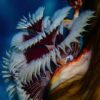Dragons and Their Imagery in Chinese Religious Statues
The dragon (龙, Lóng) has been one of the most powerful and revered symbols in Chinese culture for thousands of years. Unlike in Western traditions, where dragons are often depicted as destructive creatures, Chinese dragons are divine and benevolent, representing wisdom, strength, and protection. These mythical beings have been intricately incorporated into religious statues, where their imagery enhances the spiritual significance of deities and celestial figures.
Throughout Chinese history, dragons have been depicted in statues of Taoist, Buddhist, and folk deities, symbolizing their divine power and celestial authority. These statues, often found in temples, shrines, and ancestral halls, reflect the deep-rooted connection between dragons and spiritual beliefs in Chinese tradition.
This article explores the role of dragons in Chinese religious statues, examining their symbolism, historical evolution, and the deities they are associated with.
1. The Symbolic Role of Dragons in Religious Art
Dragons as Celestial Beings
In Chinese mythology, dragons are celestial creatures that connect the heavens and the earth. They are often depicted in statues of gods, immortals, and emperors, symbolizing divine authority and cosmic balance. Their presence in religious statues conveys:
- Heavenly power: Dragons are often carved around deities to emphasize their supernatural abilities.
- Protection: Many statues feature dragons to symbolize the deity’s role as a guardian.
- Wisdom and longevity: Dragons are seen as wise beings that guide the spiritual world.
The Dragon as a Guardian of Temples
Many religious sites in China feature stone dragon statues at their entrances, serving as protectors of sacred spaces. These dragon statues are believed to:
- Ward off evil spirits and negative energy.
- Protect the temple and its worshippers from misfortune.
- Enhance the spiritual power of the deities inside.
For this reason, guardian dragons are commonly placed outside Taoist and Buddhist temples, where they stand watch over the faithful.
2. Dragons in Taoist Religious Statues
The Dragon as a Symbol of Immortality
In Taoism, dragons are associated with immortality, transformation, and divine wisdom. Many Taoist deities are depicted standing on or holding dragons, emphasizing their control over the natural and supernatural realms.
One of the most well-known Taoist figures connected with dragons is the Eight Immortals (八仙, Bāxiān). These legendary beings, who achieved immortality through Taoist practices, are often depicted riding dragons or interacting with them in statues.
The Jade Emperor and His Dragon Throne
The Jade Emperor (玉皇大帝, Yù Huáng Dàdì), the supreme ruler of the heavens in Taoist cosmology, is frequently portrayed sitting on a throne decorated with dragons. This imagery symbolizes his absolute authority over the universe.
In statues, the Jade Emperor’s dragons are often shown:
- Coiling around his throne, representing the celestial forces under his command.
- Flying beside him, symbolizing his role as the ruler of heaven and earth.
- Holding a pearl in their claws, signifying divine wisdom and enlightenment.
Xuanwu: The Black Dragon Guardian
Xuanwu (玄武), also known as the Dark Warrior, is a Taoist deity often depicted with a dragon and a turtle, symbolizing strength and endurance. Statues of Xuanwu frequently show him standing atop a dragon, reinforcing his status as a protector of the north and a vanquisher of evil.
3. Dragons in Buddhist Religious Statues
The Dragon King and Buddhist Legends
In Buddhist mythology, dragons are seen as divine beings that protect the Dharma (Buddhist teachings). The most famous dragon figure in Buddhism is the Dragon King (龙王, Lóngwáng), a powerful deity who controls the seas and brings rain.
Statues of the Dragon King are commonly found in Buddhist temples, often depicted as:
- A human figure with dragon features, such as scales or a tail.
- Riding a dragon to symbolize his command over water and the weather.
- Holding a precious pearl, representing wisdom and enlightenment.
Buddhists believe that the Dragon King sheltered the Buddha during a great storm, showing his devotion to the path of enlightenment.
The Buddha and the Dragon Protector
Another important legend tells of Nāga (龙族, Lóngzú), a race of dragon-like beings who protected the Buddha. One of the most famous Nāga is Mucalinda, a serpent-dragon who coiled around the Buddha to shield him from a storm while he meditated.
Statues of this scene often depict:
- The Buddha seated in meditation, with a multi-headed dragon coiled behind him.
- The dragon spreading its hood over the Buddha, offering him shelter.
- A serene expression on the Buddha’s face, symbolizing his enlightenment despite external challenges.
This imagery reinforces the dragon’s role as a guardian of wisdom and spiritual purity.
4. Dragons in Chinese Folk Religion
The Dragon God of Rivers and Rain
In Chinese folk religion, dragons are often seen as gods of water and rain. Many villages have shrines dedicated to the Dragon God (龙神, Lóngshén), who ensures timely rains and agricultural prosperity.
Statues of the Dragon God commonly depict:
- A majestic dragon emerging from waves, symbolizing his control over water.
- A bearded deity riding a dragon, representing his divine status.
- A golden dragon wrapped around a staff, signifying authority over nature.
During droughts, people perform rituals at Dragon God statues, praying for rain and protection.
Mazu and the Sea Dragons
Mazu (妈祖), the goddess of the sea, is often shown accompanied by dragons, symbolizing her ability to calm storms and guide sailors safely home.
Statues of Mazu frequently feature:
- Two dragons coiled around her throne, representing her dominion over the ocean.
- A dragon at her feet, demonstrating her mastery over nature’s forces.
- Golden dragon carvings on her robes, signifying her divine protection.
Mazu’s association with dragons highlights the deep cultural belief in dragons as protectors of travelers and seafarers.
5. The Evolution of Dragon Imagery in Religious Statues
Over the centuries, the depiction of dragons in religious statues has evolved. Some notable trends include:
- Early depictions (Han Dynasty and earlier): Dragons were abstract and stylized, often appearing as coiled serpents with mystical energy.
- Tang and Song Dynasties: Dragons became more detailed and dynamic, with expressive faces and elaborate scales.
- Ming and Qing Dynasties: Statues featured highly realistic dragons with fierce expressions, often seen in imperial palaces and temples.
- Modern interpretations: Contemporary dragon statues blend traditional and artistic styles, incorporating elements of both religious devotion and artistic creativity.
Today, dragon imagery continues to be an essential element of Chinese religious and cultural heritage, symbolizing strength, protection, and divine power.
Conclusion
Throughout Chinese history, dragons have played a vital role in religious statues, temple carvings, and spiritual iconography. As symbols of divine protection, celestial authority, and wisdom, dragons have been closely associated with Taoist, Buddhist, and folk deities.
From the Jade Emperor’s dragon throne to the Dragon King’s oceanic power, these mythical beings continue to be revered in Chinese temples and shrines. Even in modern times, dragon statues remain an important part of religious and cultural traditions, representing the enduring legacy of Chinese spirituality and mythology.



